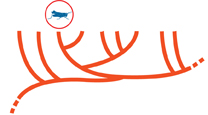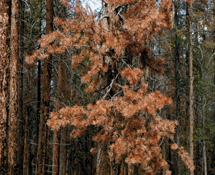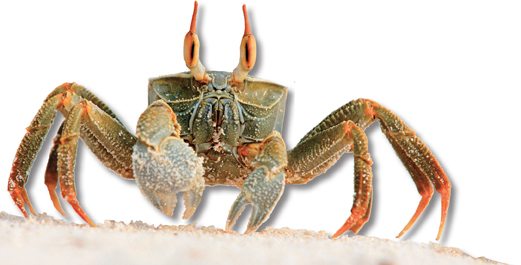Arthropods

KEY CHARACTERISTICS
Arthropods are the most diverse of all multicellular organisms. They have segmented bodies and jointed appendages. They are supported by tough exoskeletons made of chitin, which they periodically shed as they grow. Arthropods are coelomate protostomes with bilateral symmetry.
Eco•Alert
Beetle Damage
You probably know that some insects can seriously damage crop plants. But insects affect plants in natural habitats, too. One example is the mountain pine beetle, which is dramatically extending its range. Global warming appears to be enabling the beetle to survive farther north, and at higher altitudes, than it used to. The new beetle infestation is causing extensive damage to northern and high-altitude forests in North America. The death of millions of acres of trees has resulted in the release of large amounts of carbon dioxide, a greenhouse gas, into the atmosphere. You can see the sort of damage the beetles cause in the photo at right.

Mountain pine beetle damage to pine trees in White River National Forest, Colorado
Feeding and Digestion Extremely diverse: herbivores, carnivores, detritivores, parasites, blood-suckers, scavengers, filter feeders; digestive system with two openings; many feeding specializations in different groups
Circulation Open circulatory system with heart and arteries
Respiration Terrestrial—tracheal tubes or book lungs; aquatic—gills or book gills (horseshoe crabs)
Excretion Terrestrial—Malpighian tubules; aquatic—diffusion into water
Response Well-developed nervous system with brain; sophisticated sense organs
Movement Muscles attached internally to jointed exoskeletons
Reproduction Usually sexual, although some species may reproduce asexually under certain circumstances; many undergo metamorphosis during development

Most animals, including this land crab, are arthropods.
Table of Contents
- Formulas and Equations
- Applying Formulas and Equations
- Mean, Median, and Mode
- Estimation
- Using Measurements in Calculations
- Effects of Measurement Errors
- Accuracy
- Precision
- Comparing Accuracy and Precision
- Significant Figures
- Calculating With Significant Figures
- Scientific Notation
- Calculating With Scientific Notation
- Dimensional Analysis
- Applying Dimensional Analysis




